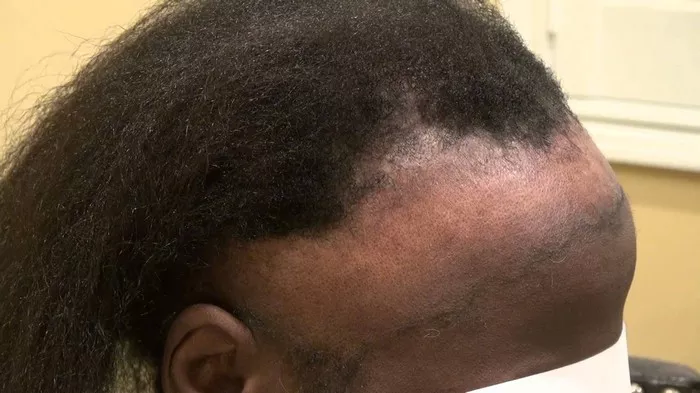Hair loss can be a distressing experience for both men and women, affecting confidence and self-esteem. When hair loss occurs specifically in the middle of the head, it can be particularly perplexing. In this comprehensive article, we delve into the potential causes of hair loss in the mid-scalp area and explore effective solutions to address this common concern.
1. The Mid-Scalp Hair Loss Phenomenon
Hair loss in the middle of the head, also known as mid-sagittal hair loss or vertex hair loss, occurs at the vertex or crown area. This pattern of hair thinning can create a visible divide on the scalp and is commonly associated with male and female pattern baldness.
2. What are the causes of hair loss in the middle of the hair?
Several factors could contribute to hair loss in the mid-scalp area:
2.1. Androgenetic Alopecia
Androgenetic alopecia, commonly referred to as male or female pattern baldness, is the most prevalent cause of mid-scalp hair loss. It is believed to be influenced by genetics and hormonal factors, particularly the hormone dihydrotestosterone (DHT), which can lead to the miniaturization of hair follicles and gradual hair thinning.
2.2. Aging
As individuals age, hair growth cycles can shorten, leading to reduced hair density in various areas of the scalp, including the mid-scalp.
2.3. Hormonal Changes
Hormonal fluctuations, such as those experienced during pregnancy, menopause, or due to hormonal disorders, can contribute to mid-scalp hair loss.
2.4. Stress and Telogen Effluvium
Intense or prolonged stress can trigger a condition called telogen effluvium, where a large number of hair follicles prematurely enter the resting phase and subsequently shed. This can result in diffuse hair loss, including the mid-scalp area.
2.5. Nutritional Deficiencies
A lack of essential nutrients, particularly vitamins and minerals important for hair health, can contribute to hair loss in various areas of the scalp.
2.6. Hairstyles and Traction Alopecia
Tight hairstyles that pull on the hair, such as ponytails, braids, or hair extensions, can lead to traction alopecia, which affects the hairline and mid-scalp region.
2.7. Medical Conditions and Medications
Certain medical conditions, scalp disorders, or medications may also contribute to mid-scalp hair loss.
3. Approaches to Address Mid-Scalp Hair Loss
While mid-scalp hair loss can be a challenging concern to address, several approaches can help manage and improve the condition:
3.1. Topical Treatments
Over-the-counter or prescription topical treatments containing minoxidil can stimulate hair growth and slow down hair loss. These solutions can be directly applied to the affected area.
3.2. Prescription Medications
For androgenetic alopecia, oral medications like finasteride can be prescribed to block the conversion of testosterone to DHT, potentially slowing down hair loss.
3.3. Laser Therapy
Low-level laser therapy (LLLT) devices, such as laser combs or caps, can stimulate hair follicles and promote hair growth when used consistently.
3.4. Hair Transplantation
For individuals seeking a more permanent solution, hair transplantation procedures can transplant healthy hair follicles from donor areas to the mid-scalp region.
3.5. Lifestyle Changes
Practicing stress-reduction techniques, maintaining a balanced diet, and ensuring adequate nutrition can support overall hair health.
3.6. Hair Care Practices
Avoiding tight hairstyles that cause tension on the hair and scalp can help prevent traction alopecia.
3.7. Scalp Care
Maintaining a clean and healthy scalp can create a conducive environment for hair growth. Use gentle, sulfate-free shampoos and avoid excessive heat styling.
4. Should hair loss in the middle of the hair seek expert advice?
If you are experiencing hair loss in the middle of the hair, seeking expert advice from a dermatologist or trichologist is recommended. Hair loss can be caused by various factors, and identifying the specific cause is essential for determining the most appropriate treatment plan.
A professional hair expert can perform a thorough examination of your scalp and hair, review your medical history, and discuss any potential contributing factors. They can also conduct tests if necessary to diagnose the underlying cause of the hair loss accurately.
While some cases of mid-scalp hair loss may be related to common factors like aging or stress, it’s crucial to rule out underlying medical conditions, hormonal imbalances, or genetic factors, such as androgenetic alopecia. These issues may require targeted treatments or medications to manage or slow down hair loss effectively.
Additionally, an expert can provide personalized advice on lifestyle changes, dietary adjustments, and hair care practices that can support overall hair health and potentially improve hair regrowth.
Remember that seeking professional advice can provide valuable insights into your specific hair loss situation and increase the chances of finding the most effective solutions for your needs.
5. In conclusion
Mid-scalp hair loss can stem from various factors, including androgenetic alopecia, hormonal changes, stress, and nutritional deficiencies. By understanding the potential causes and implementing suitable approaches, individuals can effectively manage and address mid-scalp hair loss.
Remember that each individual’s hair loss journey is unique, and results from treatments may vary. Embrace your unique path and seek professional guidance to navigate the options available. With a comprehensive approach to hair care and the support of expert advice, you can embark on a journey of hair health and self-confidence.


